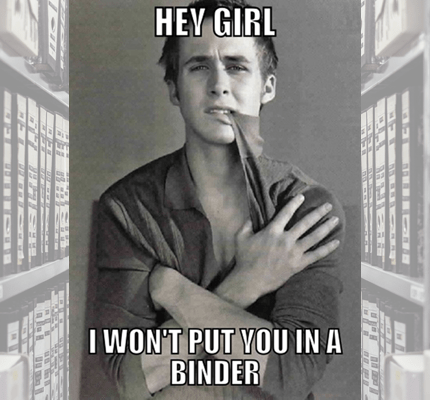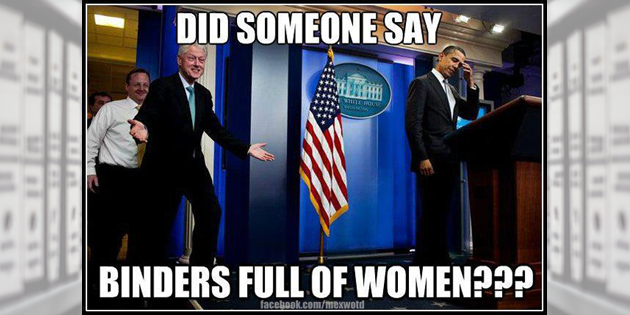
What We Have Here is a Failure to Visually Communicate
In what seems like another era but was only five years ago, presidential candidate Mitt Romney made a verbal gaffe that echoed far beyond the debate hall and turned into a pop culture meme. Critics immediately denounced his “binders full of women” comment as inappropriate, and dozens of images mashing Romney’s words up with the likes of Ryan Gosling, Bill Clinton, and other prominent personalities went viral.
Beyond the obvious blending of politics and pop culture and a case study in how the internet and social media can quickly shine a spotlight on mistakes, Emily Stones of Regis University argues that these types of memes offer an opportunity to teach visual rhetoric and reason. In a recent article in Communication Teacher, Stones describes a hands-on classroom activity that uses popular political memes to help students explore “the impact of perceived relations and social order in political discourse.”

Here is a summary of Stones’ suggested activity:
- Select two or three political image-based meme series (each based on a different topic) from recent years that may be familiar to your students, using a site such as knowyourmeme.com, and print out several copies to review. *
- Provide the necessary context and background for each meme, whether it is an original image, sound bite, or video (as in the case of the Romney debate clip), and ask student to speculate on why it may be deemed controversial.
- When introducing the meme series, ask students to rank the offending incident or person within a list of other cultural figures – in this case, regarding their treatment of and attitudes toward women. Stones notes that the purpose of the exercise is not to judge the offensive statement or action itself, but to “see how members of the public made sense [of it]” within a particular social order. Students should explain their rationale for each set of rankings.
- Following the activity, the instructor should ask the students to revisit their initial assessment of the controversial incident, and to engage in discussion around these questions:
- Did the meme series make it more offensive or less so, and why?
- Is the meme series a fair representation of what happened?
- What happens when we use cultural figures to create a social order, and what gets left out of the conversation about women’s rights?
Stones says this type of visual reasoning activity reinforces other concepts instructors may have covered in class, such as:
- Images act as enthymemes, in which the audience must make sense of an implied argument.
- Circulation of images changes the messages’ meaning and impact.
- Memetic arguments are based on visual commonplaces, or familiar representations of collective memories and cultural knowledge.
- Logic and rationality are not the only contributors to political decision making: metaphors and framing make a difference.
While in the moment, we may laugh at a seemingly harmless meme and perpetuate its virality without a second thought, Stones believes that memes “provide a fresh lens” for visual communication concepts and “cement the paradigmatic shift students need to experience in order to process the implications of our visual culture.”
*Stones used “Pepper Spray Cop” as a second meme series example.


